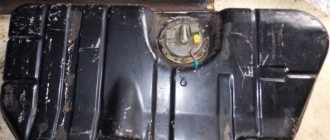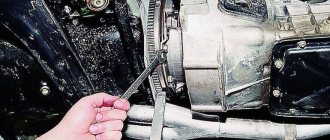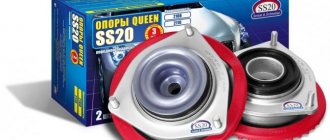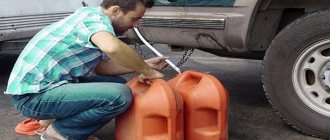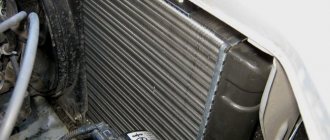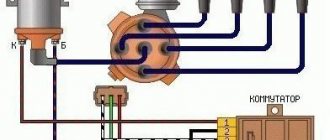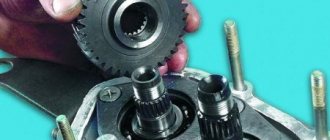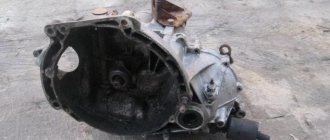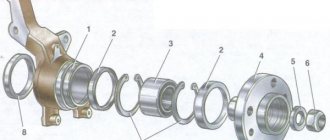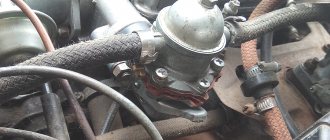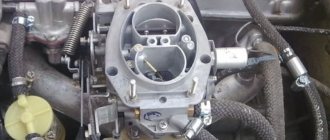Bleeding the brakes of VAZ 2108, 2109, 21099 cars
Before carrying out work on pumping the brake system, you should remember some of its features for front-wheel drive VAZ passenger cars. The brake system of VAZ 2108, 2109, 21099 cars is hydraulic, has two circuits: right rear wheel - front left, left rear - front right.
Brake system of VAZ 2108, 2109, 21099 cars
Bleeding the brakes should start from the right rear wheel. A sign of airiness in the brake system is a decrease in braking efficiency when you press the brake pedal. Bleeding the brake system on VAZ 2108, 2109, 21099 vehicles must be carried out after repairing or replacing its elements, replacing the brake fluid (according to the regulations, once every five years).
Required tools and materials
- a special wrench for unscrewing the fittings on the brake cylinders
- 8 mm spanner
— container (0.5 l) for brake fluid
- rubber tube (50-70 cm), preferably transparent
Preparatory work
- put the car in a pit
If we are bleeding the brakes without a hole on a flat surface, with the wheels removed, it is necessary to open the pressure regulator valve (sorcerer), otherwise, when the rear wheels are suspended, it will block the passage of brake fluid into the brake cylinders of the rear wheels. To do this, we insert a slotted screwdriver between the lever and the plate, forcing the pressure regulator rod into place.
- install chocks under the wheels
— open the brake fluid reservoir cap and fill it to the brim
When bleeding the brakes, make sure that the level in the reservoir does not drop to the min mark; if necessary, add brake fluid to it.
Bleeding the brakes of VAZ 2108, 2109, 21099 cars
— Clean the fitting on the brake cylinder of the rear right wheel from dirt
— Remove the protective cap from it
— We put a special wrench or 8 mm socket wrench on the fitting
— We put one end of the rubber tube on the fitting, lower the other end into a container with brake fluid
Fill it at least by a third.
Bleeding the rear brakes on a VAZ 2108, 2109, 21099
— An assistant must slowly press the brake pedal 5-6 times to create pressure in the system and hold it pressed
— Unscrew the fitting on the brake cylinder approximately half a turn
We observe how the brake fluid with air bubbles comes out of the tube into the container. After it stops coming out:
— We wrap the bleeder fitting
- Repeat the procedure again
The assistant again presses the brake pedal several times and holds it down, unscrew the fitting half a turn, the fluid flows out for a while.
Do not forget to add brake fluid to the reservoir, as the level in it will constantly drop.
— We carry out bleeding until the brake fluid stops coming out along with air bubbles, and only brake fluid comes out
Then we finally tighten the fitting.
We repeat a similar procedure sequentially for the front left wheel, rear left, front right.
Notes and additions
— After bleeding the brakes on a VAZ 2108, 2109, 21099, press the brake pedal and check the operation of the hydraulic drive. If the pedal is “soft” and drops below its normal operating position (when pressed, it travels more than half the distance to the floor), we check the serviceability (tightness) of the brake system elements and carry out bleeding again.
— In addition to putting the car’s working brake system in order, once every 15,000 km the parking brake system (handbrake) of VAZ 2108, 2109, 21099 vehicles should be checked and adjusted.
Article: 10.3839 000
Order code: 000624
In stock Available for order - >10 pcs. Data updated: 03/18/2021 at 02:30
Order code
000624 Articles 10.3839000 Manufacturer SOATE Catalog group: ..Instruments and sensors Electrical equipment Width, m: 0.05 Height, m: 0.05 Length, m: 0.08 Weight, kg: 0.045
Reviews of the product
Where is it used?
- Trucks and trailers / GAZ / GAZ-3309 (Euro 2) 2 drawings
Emergency brake fluid level sensor Brakes / Master cylinder reservoir - Emergency brake fluid level sensor Brakes / Master cylinder reservoir
- Emergency brake fluid level sensor Brakes / Brake drive elements
- Emergency brake fluid level sensor Brakes / Brake drive elements
- Emergency brake fluid level sensor Brakes / Brake drive elements
- Emergency brake fluid level sensor Brakes / Brake drive elements
- Emergency brake fluid level sensor Brakes / Brake drive elements
- Emergency brake fluid level sensor Brakes / Brake drive elements
- Emergency brake fluid level sensor Brakes / Brake master cylinder parts, master cylinder reservoir, emergency brake fluid level sensor
- Emergency brake fluid level sensor Brakes / Brake master cylinder parts, master cylinder reservoir, emergency brake fluid level sensor
- Emergency brake fluid level sensor Brakes / Brake master cylinder parts, master cylinder reservoir, emergency brake fluid level sensor
- Emergency brake fluid level sensor (10.3839000) Brakes / Brake master cylinder parts, emergency brake fluid level sensor
- Emergency brake fluid level sensor Brakes / Brake drive elements (11,12,13,30)
- Emergency brake fluid level sensor Brakes / Brake drive elements
- Emergency brake fluid level sensor Brakes / Brake drive elements
- Emergency brake fluid level sensor Brakes / Brake drive elements
- Emergency brake fluid level sensor Brakes / Brake drive elements
- Emergency brake fluid level sensor Brakes / Brake drive elements
- Emergency brake fluid level sensor Brakes / Brake drive elements
- Emergency Brake Fluid Level Sensor Brakes / Brake Master Cylinder Reservoir, Emergency Brake Fluid Level Sensor and Brake Master Cylinder Parts
- Emergency brake fluid level sensor Brakes / Brake master cylinder parts, master cylinder reservoir, emergency brake fluid level sensor
- Emergency brake fluid level sensor Brakes / Brake master cylinder parts, master cylinder reservoir, emergency brake fluid level sensor
- Emergency brake fluid level sensor Brakes / Brake drive elements (11, 12, 13, 30)
Certificates
Reviews
There are no reviews for this product yet.
Write a review
- Tank sensor GTZ VAZ-2108.09, GAZ-3302, ZAZ-1102 SOATE Article: 10.3839000 Order code: 000624 330 ₽ or place an order by calling 8 800 6006 966
Availability of goods in warehouses and stores, as well as the price of the goods is indicated on
18.03.2021 02:30
.
Prices and availability of goods in all stores and warehouses are updated once an hour.
If there is a sufficient quantity of goods in the store you need, you can buy it without pre-ordering. Internet price
- valid when ordering on the website or through a call center operator by phone
8-800-600-69-66
. Subject to sufficient quantity of goods at the time of order.
Price in stores
— retail price of goods in store sales areas without pre-order.
The period for moving goods from a remote warehouse to the warehouse of an online store.
The parts data presented on this page is for informational purposes only.
c8b0b6ba8ece9ad81d282a298aef6ed6
Add to cart
Available to order:
Order quantity:
Product successfully added to cart
!
How to prepare and pump a car
To begin with, we remind you once again that air enters the brake system after repairs such as replacing brake fluid, cylinders, pads, brakes or other components.
If the owner of a VAZ-2109 car noticed that the brakes stopped functioning properly immediately after carrying out the above work, then there is a possibility that there is no need to bleed the entire system. And all because it has a front and rear contour. And you need to focus on the one in which the repairs were carried out.
In a situation where the main brake cylinder was removed or the pipes were replaced, the entire system must be bled, and a strict scheme must be followed.
- You need to start with the right rear wheel.
- Then move to the front left.
- Next on the list is the rear left wheel.
- And the work is completed with the front right.
Also, before pumping, the following is necessary.
- Check the brake fluid level in the expansion tank (it should be at the maximum level, and if it is less, you need to add the missing part).
- Brake fluid is poured into a small plastic container (this is done so that during the test you can see the air by the presence of bubbles).
- You also need to have a long hose, the diameter of which must match the diameter of the outlet pipe in the brake cylinder.
If such work is carried out using a lift, due to which the rear wheels of the car will hang in the air, you need to block the pressure regulator. Otherwise, when pumping, it will be higher than necessary. This is done simply - you need to find the brake piston, which is located under the car and adjacent to the plate, and install a flat-head screwdriver between them.
Rules for performing work
The VAZ 2109 is equipped with a brake system divided into two circuits - rear and front.
If you replaced only the front or only the rear cylinders, or other components, bleeding may well be carried out only along one of the circuits where the repair was carried out. All other situations related to removing the master brake cylinder and replacing pipes require mandatory bleeding of the entire system.
Order
Before you bleed the brakes, you should learn about the bleeding procedure. If you do not follow it, the work will not give the desired effect, and therefore the pedal may not work again.
Wheel
| Leveling procedure | |
| First stage | Rear right wheel |
| Second phase | Front left wheel |
| Third stage | Rear left wheel |
| Fourth stage | Front right wheel |
Follow this correct bleeding sequence, starting with the rear right and ending with the front right. A similar recommendation is indicated for all VAZ 2109 operating manuals.
Checking the result
Do not rush to go out on the road, because after pumping the vehicle still needs to be checked.
- Drive onto a road where there are almost no cars. In this case, the asphalt must be dry and smooth.
- Accelerate to approximately 40 kilometers per hour.
- Depress the brake pedal while blocking the wheels.
- Keep your foot on the pedal until the car comes to a complete stop.
- Use a tape measure to measure the braking distance.
- Repeat the procedure, driving in the opposite direction.
- Check the braking distance readings. If they are normal, you can safely continue to operate your own car.
Braking distance According to the technical standards for the operation of the VAZ 2109, the operation of the braking system must ensure a braking distance of 12.2 meters under the specified test conditions (dry asphalt, speed 40 kilometers per hour).
The work is completed, so you can safely hit the road. Now the pedal will accurately respond to your manipulations.
labavto.com
Brakes are one of the most important systems of a vehicle. They must always be in good condition, as safety on the road depends on them. One of the procedures that is carried out during brake repair is bleeding the brake system (TS). On a VAZ 2109 it is not difficult to carry out it, acting step by step according to the instructions.
Why do you need to bleed your brake system?
This procedure is carried out to restore its functionality and effectiveness. Air is removed from the vehicle lines by pumping. This procedure is carried out after carrying out any measures with the brake system:
During repair work and brake replacement, air may enter the system. Its presence in vehicle lines is very dangerous - the brake pedal simply does not respond to pressure and it is impossible to stop the car. Therefore, its removal is necessary.
When working with brake fluid, you must be careful, as it and its vapors are very toxic. It is advisable to work with gloves. If brake fluid gets on your skin, it should be washed off immediately with warm soapy water. Do not allow the fluid to come into contact with wires or plastic parts and trim while pouring fluid into the reservoir.
Basic pumping rules and preparatory activities
The brake system of the VAZ 2109 consists of two independent circuits. If one of them fails, the other operates, this increases traffic safety. If work was carried out on only one of the cylinders or other elements of the brake system, then pump the corresponding circuit on which the repair was carried out. If brake hoses, brake fluid were changed, or the master cylinder was removed, it is necessary to bleed both circuits.
Bleeding is carried out in a strictly defined order; if it is not followed, the procedure will be useless and problems with the pedal will remain. You can pump only one circuit. If both are pumped, then start the process from the rear right wheel. Next they move to the left wheel in front. Next, they return to the rear wheel pair and bleed the rear left wheel, and finish on the front right one. The procedure for pumping the vehicle is described in the “nine” manual.
Checking the result
Do not rush to go out on the road, because after pumping the vehicle still needs to be checked.
- Drive onto a road where there are almost no cars. In this case, the asphalt must be dry and smooth.
- Accelerate to approximately 40 kilometers per hour.
- Depress the brake pedal while blocking the wheels.
- Keep your foot on the pedal until the car comes to a complete stop.
- Use a tape measure to measure the braking distance.
- Repeat the procedure, driving in the opposite direction.
- Check the braking distance readings. If they are normal, you can safely continue to operate your own car.
Braking distance
According to the technical standards for the operation of the VAZ 2109, the operation of the braking system must ensure a braking distance of 12.2 meters under the specified test conditions (dry asphalt, speed 40 kilometers per hour).
The work is completed, so you can safely hit the road. Now the pedal will accurately respond to your manipulations.
How can you bleed the brakes on a VAZ-2109 yourself?
Bleeding helps to remove air from the main pipes of the brake system so that the use of this unit can be effective. It is recommended to do this work after any intervention, such as replacing the master cylinder, brake fluid or brake fluid pipes. If there is air in the system, then when the brake pedal is used, the pads will not react in any way to the driver’s command. Let's figure out how to bleed the brakes if you have a VAZ-2109.
Which wheel to start with?
After replacing the brake master cylinder, work should be carried out on the entire circuit. In this case, it is necessary to follow the pumping scheme. You will have to work in the following order:
- bleed the rear wheel on the right;
- go to the front wheel on the left;
- deal with the rear left wheel;
- complete the work at the front right wheel.
This recommendation is contained in all repair instructions for VAZ-2109 vehicles. Please note that the contours on the VAZ-2109 have a diagonal division, so it is necessary to bleed the wheels located diagonally.
For example, you repaired the front part of the brake mechanism on the left, which means you need to start bleeding from the rear right.
Preparing for work
Pumping will not be effective unless you first carry out a number of preparatory measures to prepare the system for intervention:
- Check the amount of brake fluid in the conservator tank. It should be at the maximum level. If necessary, add more until the level reaches maximum.
- Prepare a clean plastic container in which to place some brake fluid.
- Take a hose whose diameter is equal to the size of the brake fittings. It must be of sufficient length.
- If you have placed the car on jacks or a special lift, then you need to insert a flat-head screwdriver between the piston and the plate. This technique will help you block the pressure regulator.
- Loosen the fittings slightly.
One of the most important recommendations is to have an assistant to carry out the work. This could be any person, even those who do not understand car repair issues. He has a simple job to do.
How to carry out repairs with an assistant
Getting the job done right is not difficult if you find someone to help you. Bleeding is performed according to the instructions:
- To create pressure in the system, the assistant must press the brake pedal about 9 times at short intervals. After the last press, it must be pushed into the floor and not released.
- At the same time, place the hose on the loosened cylinder fitting. This will allow air to escape from the system.
- The end of the hose is placed in a prepared container with brake fluid. If you do everything correctly, its level will begin to rise, as it will begin to leave the circuit along with the air.
- Bubbles will tell you that air is escaping. As soon as they stop appearing, the air lock has left the system.
- Tighten the fitting and again ask an assistant to pump the system using the pedal about 9 times at short intervals. After completing the work, return the fitting caps to their place.
These manipulations must be carried out with each cylinder affected by the repair in turn. Only rear or front brake cylinders can be made this way. Before bleeding each brake mechanism, it is necessary to add fluid to the expansion tank, as it will leak out during the work. Pour only new fluid, and not the one you have in the pumping container. After all, the latter contains air bubbles that will reduce all your work to zero.
Preliminary activities
By properly preparing for the upcoming brake system bleeding, you can seriously save on car service costs. Watch the video, read our instructions to gain the necessary experience and upgrade the vehicle yourself
Among the preliminary activities, we highlight the following.
Leveling up
Now let’s proceed directly to bleeding the brake system of your VAZ 2109. By following certain instructions and observing the sequence of actions, you will be able to complete the task more easily with four hands.
During the pumping process, the coolant will gradually come out of the expansion tank. As the quantity decreases, do not forget to fill it with new composition. It is not worth pouring fuel fluid from the container for pumping, since, as you remember, there are air bubbles there.
Having completed the procedure for bleeding the brake system, tighten the fittings and put the caps on them.
Bleeding brakes on a VAZ 2022, preparation and sequence of actions
Bleeding the VAZ 2109 brakes is carried out in a sequence strictly determined by the design features, namely:
- Rear right wheel (farthest wheel in the system);
- Front left (connected by the system to the already pumped rear right wheel);
- Rear left;
- Front right.
The sequence is this way because of the diagonal placement of the contours. All steps must be completed when pumping along the full circuit. You can only upgrade one at a time.
To work you will need:
Note. Brake fluid is quite aggressive; it should not come into contact with the skin and should be washed off immediately. It is also undesirable for it to come into contact with plastic parts, wires, or in the eyes; TJ vapors are poisonous.
Preparing to bleed the brakes
To properly bleed the brakes on a VAZ 2109, as necessary, you will need competent preparation according to the following scheme:
Be sure to check the system for leaks and inspect all pipelines and parts. The machine is installed on a pit or raised with a jack. Tubes, connections, hoses must be carefully cleaned with a rag, then press the brake several times and secure. When inspecting, connections and hoses must not be wet. Detected leaks are eliminated by tightening the fasteners or replacing problematic parts.- Make sure that the fluid level in the tank is maximum; if not, top up. The level will have to be checked after bleeding each mechanism, otherwise air will enter the system again.
- Pour a little liquid into the draining container so that the bubbles escaping from the system are visible.
- The fittings must be loosened before starting work.
- You also need to remember that the VAZ 2109 has a rear wheel drive pressure regulator. When pumping, it is necessary to create high pressure in the system. To prevent the regulator from blocking the flow of fluid to the rear wheels, when working without a pit, on a jack, you need to open its valve and keep it in this form until the end of work. To do this, it is enough to install, for example, a flat screwdriver between the plate and the regulator rod, pushing the rod all the way. The screwdriver is removed upon completion of work.
It is more convenient to pump the brakes on a VAZ 2109 with two people; if you work independently, the cost of brake fluid, time, and effort will increase, but it is possible to cope with the task.
How to bleed the brakes on a VAZ 2109, working together
If you have a partner (no qualifications are required from him), the action plan is as follows:
- The driving partner creates the required pressure in the system by depressing the brake pedal (5-9 presses are needed), then holds the pedal in the lower position until the bleeding is completed.
- The one under the car puts a hose on the fitting of the right rear cylinder and completely releases the fitting so that the liquid flows. The end of the hose must first be lowered into a container for draining. By the bubbles in the liquid you can judge the state of the system and notice when all the air has been removed.
- After complete cleaning, the fitting is tightened and the pedal is released, you can move to the next wheel, the diagram is the same, the front left wheel.
- The level of brake fluid in the reservoir will decrease as pumping progresses and will need to be restored to the maximum level.
- After bleeding along a full (or one, as necessary) circuit, the fittings must be finally tightened and the protective caps must be put on.
If you have to work independently, the scheme and sequence of actions are almost the same. You can press the pedal yourself, or you can use an aerator (price up to 150 rubles).
- The aerator adapter is connected to the pump, possibly with an inflated tire;
- The required wheel is removed from the jacked up car;
- Instead of its own lid, the aerator lid is screwed onto the tank;
- After loosening the fitting, pumping is performed according to the general scheme.
When pumping in this way, the wheel spool is used instead of a compressor, and in extreme cases, the brake is squeezed out and pressed down with a stone until the pumping is complete.
Bleeding using a stop
It is possible to do without a spare wheel or a compressor. All you need is a transparent hose, a container for draining the brake fluid and an additional stop of some kind. It is convenient to use the gas stop from the hood, but an ordinary stick of the required length will do to reach from the brake pedal in the lower position to the driver’s seat.
- If necessary, add brake fluid to the reservoir.
- Press the brake pedal sharply until you feel significant resistance.
- We fix it with a support, which we install between the pedal and the seat frame.
- We connect the brake bleeder fitting to the hose, the other end of which is lowered into a container with liquid, and open the fitting. The liquid and air will drain into the container. When the air in the system runs out (no bubbles will be visible in the transparent hose), close the fitting.
- Add fluid again, press the pedal several times, fix it and move on to the next wheel. The pumping order is from the furthest wheel relative to the central tank to the nearest wheel.
Checking the brake system
VAZ 2109 bleed the brakes
Before starting this work, it is necessary to check the entire system for its tightness. To do this, place the car in a garage with an inspection hole. Carefully clean the joints of rubber hoses and pipelines from accumulated dirt.
Note: do not use sharp objects, do not strike.
You need to clean it carefully - take a rag with your hands, rotate it up and down, clean one side, then the other. After this, you need to make several presses on the pedal, put a load on it or stop it with something else. Necessary:
- Go down into the pit.
- Inspect the connections and the quality of the hoses themselves.
- The joints must be dry.
- If liquid has leaked, then use gentle movements and a special wrench to tighten the connections.
Note: tightening must be done smoothly without sudden movements. Tightening the tube connections is carried out with two wrenches and they need to be installed on the two parts being connected.
- Inspect the places where the pipes are attached to the car body; if they break, make new fastenings if possible. Install them in certain parts of the body.
VAZ 2109 bleeding the brake system
- Securely secure the tubes.
- Visually assess the suitability of the rubber hoses; they should not have ruptures in the upper shell or cracks.
Premature damage to rubber hoses can occur due to:
- drainage of mineral oils and grease onto them;
- as well as mechanical damage.
According to the technical specifications of the manufacturer, hoses must be changed after 150,000 km or after five years of operation of the vehicle. Upon completion of the inspection of the condition of the system from the inspection hole, under the body of the vases, it is necessary to inspect all joints for tightness. This is also done under the hood, in the engine part. In addition, it is necessary to check the fluid level in the master cylinder reservoir. If necessary, the level must be increased to the maximum level.
Pads
When braking, a grinding noise is heard from the front wheels. Most often this happens due to worn pads. This consumable consists of a metal base and a friction lining. It is this pad that stops the car by friction against the disc. During operation, the friction material gradually wears off. When it is completely erased, the base begins to rub against the disc. This is what causes the grinding noise. Sometimes, when the pads are worn too much, the caliper working cylinders can be squeezed out and jam. This leads to increased wear of the brake discs, even to the point of cutting them off. Therefore, you should not delay replacing the pads. Be sure to change consumables on both sides
Also pay attention to other components of the brake mechanism
This is especially important if the pads wear unevenly. When choosing components, it is advisable to use “original” pads
If you purchase non-original spare parts, make sure that they can be installed correctly. Incorrect installation may cause grinding noise in the future. Sometimes a pad can break due to various reasons. Most often, the reason is their low quality. The linings crumble very often. The sharp edges resulting from this scratch the disc. Therefore, the disc must be polished when such a problem is identified. Buy spare parts only from reliable places, be sure to ask for certificates. If you had to brake suddenly and then a grinding noise started, the pads may be burnt. Remove carbon deposits from the pads with fine sandpaper. Article on the topic “Replacing brake discs and pads with your own hands”
When choosing components, it is advisable to use “original” pads. If you purchase non-original spare parts, make sure that they can be installed correctly. Incorrect installation may cause grinding noise in the future. Sometimes a pad can break due to various reasons. Most often, the reason is their low quality. The linings crumble very often. The sharp edges resulting from this scratch the disc. Therefore, the disc must be polished when such a problem is identified. Buy spare parts only from reliable places, be sure to ask for certificates. If you had to brake suddenly and then a grinding noise started, the pads may be burnt. Remove carbon deposits from the pads with fine sandpaper. Article on the topic “Replacing brake discs and pads with your own hands.”
What will you need?
Those who have had to pump the GTZ know that it is difficult to do it alone. It is indeed inconvenient to carry out bleeding on your own, so I advise you to involve an assistant in this matter, whose main task will be to press the brake pedal. You will also need automotive tools (spanners, including a bleeder wrench), fresh brake fluid and a hose.
Before you begin, I always recommend checking for damage to the hoses and tubes. If there are any, you should first replace them and then continue. Repairing a car with your own hands requires certain skills and abilities, but it is much cheaper than service stations, the main thing is to know a few rules and follow the algorithm. In order for pumping to be carried out correctly and successfully, it should be done according to a certain algorithm.
How to service the master cylinder
The design of the brake system on nines is approximately the same as on classic models. The only difference is that the parts of the VAZ-2109 brake system are much stronger and more powerful, since the car is capable of developing higher speeds, therefore, it needs to be stopped faster.
There is no need to service the master cylinder if it is functioning properly. But try to change the brake fluid, top up if necessary and make sure that there is no leakage in the system. If a leak appears from the master cylinder, it must be repaired or completely replaced.
Why pump
Bleeding is a frequently carried out measure aimed at restoring and increasing the efficiency of the braking system.
It is necessary to pump the brakes after any intervention in the design of the brake system - repair, replacement of components, change of brake fluid, cylinders, vacuum booster, etc. Bleeding allows you to remove air that has entered there from the line.
If air is in the system, at some point (as practice shows, this always turns out to be the most inopportune moment) the pedal simply will not respond to pressure. Therefore, you will not be able to slow down or stop the car. And this despite the fact that you have new brakes after replacement.
Tank with TJ
